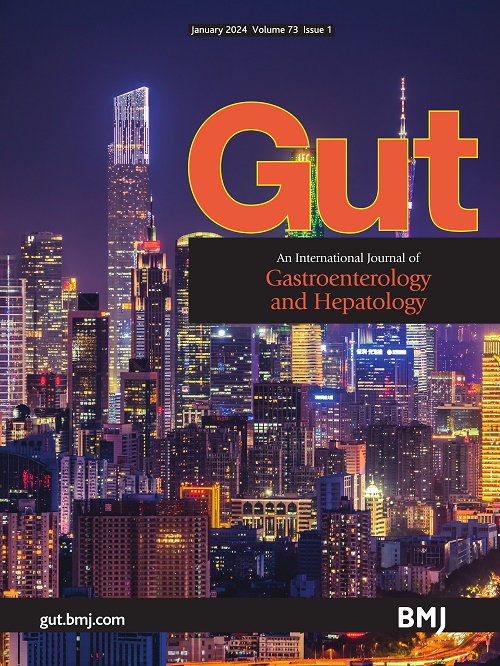Large-scale profile study on hepatitis B surface antigen levels in chronic hepatitis B: implications for drug development targeting functional cure
IF 25.8
1区 医学
Q1 GASTROENTEROLOGY & HEPATOLOGY
引用次数: 0
Abstract
Background Quantitative hepatitis B surface antigen (qHBsAg) is an important biomarker in chronic hepatitis B (CHB). Objective Establish qHBsAg profiles to guide novel drug development. Design Baseline qHBsAg profiles, longitudinal qHBsAg trajectories and predictors of HBsAg seroclearance were determined in a large CHB cohort. Results This study included 4287 patients with qHBsAg measurements between 2009 and 2020 (62.5% male; mean age 48.0; 45.2% on nucleos(t)ide analogues (NUC)) with median baseline qHBsAg of 630.8 (117.1–1875.5) IU/mL. 3437 (80.2%), 2516 (58.7%) and 997 (23.3%) patients had baseline qHBsAg <3000 IU/mL, <1000 IU/mL and <100 IU/mL, respectively (69.2%, 46.9% and 22.9% in treatment-naïve; 93.4%, 73.0% and 23.6% in NUC-treated patients correspondingly). Among patients with recent qHBsAg measurements in 2018 (n=1593), 98.9%, 71.1% and 26.9% of patients had baseline qHBsAg <3000 IU/mL, <1000 IU/mL and <100 IU/mL, respectively (99.3%, 67.1% and 34.2% in treatment-naïve; 98.7%, 73.1% and 23.0% in NUC-treated patients correspondingly). Age (OR 1.019–1.049), hepatitis B e antigen positivity (OR 0.264–0.349) and HBV DNA (OR 0.675–0.832) were independent determinants of qHBsAg <100 or 1000 IU/mL, respectively (all p<0.05). Among patients with serial qHBsAg measurements, the median qHBsAg reduction was 0.10 (0.02–0.27) log IU/mL/year. After median follow-up for 6.3 (5.7–14.3) years, 526 patients (12.3%) achieved HBsAg seroclearance. Baseline alanine aminotransferase/qHBsAg ratio ≥0.27 independently predicted HBsAg seroclearance (HR 4.904, p<0.001). Conclusion In an endemic population, >40% of patients with CHB have qHBsAg >1000 IU/mL. These patients are unlikely to achieve spontaneous HBsAg seroclearance, but also have suboptimal responses to novel antivirals. Our data has important implications for novel antiviral development. Data are available upon reasonable request.慢性乙型肝炎患者乙型肝炎表面抗原水平的大规模研究:对靶向功能性治愈药物开发的意义
背景定量乙型肝炎表面抗原(qHBsAg)是慢性乙型肝炎(CHB)的重要生物标志物。目的建立qHBsAg图谱,指导新药开发。设计在一个大型慢性乙型肝炎队列中确定基线qHBsAg概况、纵向qHBsAg轨迹和HBsAg血清清除率的预测因子。结果本研究纳入了2009 - 2020年间进行qHBsAg检测的4287例患者(62.5%为男性;平均年龄48.0岁;45.2%使用核苷类似物(NUC),基线qHBsAg中位数为630.8 (117.1-1875.5)IU/mL。3437例(80.2%)、2516例(58.7%)和997例(23.3%)患者有基线qHBsAg, 40%的CHB患者qHBsAg为1000 IU/mL。这些患者不太可能实现自发的HBsAg血清清除,而且对新型抗病毒药物的反应也不理想。我们的数据对新型抗病毒药物的开发具有重要意义。如有合理要求,可提供资料。
本文章由计算机程序翻译,如有差异,请以英文原文为准。
求助全文
约1分钟内获得全文
求助全文
来源期刊

Gut
医学-胃肠肝病学
CiteScore
45.70
自引率
2.40%
发文量
284
审稿时长
1.5 months
期刊介绍:
Gut is a renowned international journal specializing in gastroenterology and hepatology, known for its high-quality clinical research covering the alimentary tract, liver, biliary tree, and pancreas. It offers authoritative and current coverage across all aspects of gastroenterology and hepatology, featuring articles on emerging disease mechanisms and innovative diagnostic and therapeutic approaches authored by leading experts.
As the flagship journal of BMJ's gastroenterology portfolio, Gut is accompanied by two companion journals: Frontline Gastroenterology, focusing on education and practice-oriented papers, and BMJ Open Gastroenterology for open access original research.
 求助内容:
求助内容: 应助结果提醒方式:
应助结果提醒方式:


